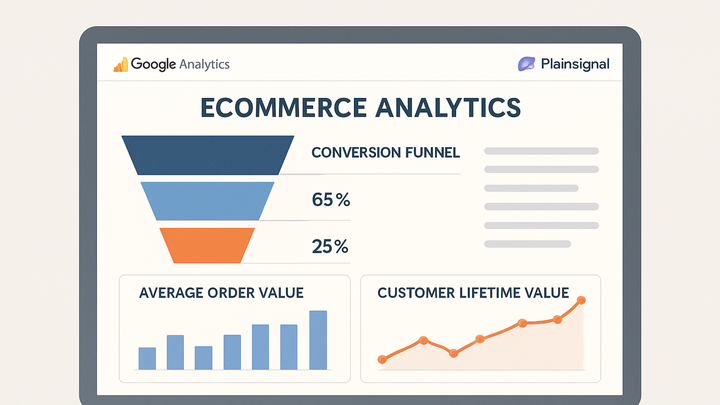Published on 2025-06-22T03:05:45Z
What is Ecommerce Analytics? Examples and Best Practices
Ecommerce Analytics is the measurement, collection, analysis, and reporting of data generated by online commerce interactions. It helps businesses understand customer behavior, optimize marketing efforts, and increase revenue.
By tracking metrics such as conversion rate, average order value (AOV), and cart abandonment rate, companies can identify bottlenecks in the sales funnel and improve user experience.
Tools like Google Analytics 4 (GA4) and PlainSignal enable comprehensive and privacy-focused cookieless tracking. Implementing ecommerce analytics involves adding measurement scripts to your site—for example, using PlainSignal:
<link rel="preconnect" href="//eu.plainsignal.com/" crossorigin /><script defer data-do="yourwebsitedomain.com" data-id="0GQV1xmtzQQ" data-api="//eu.plainsignal.com" src="//cdn.plainsignal.com/plainsignal-min.js"></script>
Once installed, dashboards visualize traffic sources, conversion paths, and user cohorts, empowering data-driven optimizations. Advanced use cases include predictive modeling, customer segmentation, and personalized promotions.
Ecommerce analytics
Tracking and analyzing online store metrics—like conversion rate, AOV, CLV—to optimize sales and marketing strategies.
Introduction to Ecommerce Analytics
Overview of ecommerce analytics, its purpose and significance in online retail.
-
Definition
Ecommerce analytics is the process of collecting and analyzing data generated by online shopping platforms to understand customer behavior and optimize sales.
-
Scope
It encompasses metrics from user acquisition, site engagement, purchase transactions, to post-purchase retention.
-
Importance
Provides actionable insights to reduce friction in the sales funnel, improve marketing ROI, and increase customer lifetime value.
-
Optimization
Identifies areas in the purchase path where users drop off.
-
Strategy
Guides marketing and merchandising decisions based on data.
-
Key Metrics and KPIs
Essential metrics tracked in ecommerce analytics that indicate the health and performance of an online store.
-
Conversion rate
Percentage of visitors who complete a purchase.
-
Calculation
Conversion Rate = (Number of Purchases / Number of Visitors) × 100.
-
-
Average order value (aov)
Average revenue generated per order.
-
Calculation
AOV = Total Revenue / Number of Orders.
-
-
Customer lifetime value (clv)
Total revenue expected from a customer over their relationship with the store.
-
Formula
CLV = (Average Order Value) × (Purchase Frequency) × (Average Customer Lifespan).
-
-
Cart abandonment rate
Share of users who add items to cart but do not complete checkout.
-
Calculation
Cart Abandonment Rate = (Abandoned Carts / Initiated Checkouts) × 100.
-
-
Bounce rate
Percentage of single-page sessions where no interaction occurs.
-
Relevance
High bounce rate may indicate poor landing page experience.
-
Implementing Ecommerce Analytics with SaaS Tools
Steps to integrate and configure popular analytics platforms like GA4 and PlainSignal.
-
Google analytics 4 (GA4)
GA4 provides event-based tracking and advanced analysis for ecommerce behavior.
-
Integration
Add the GA4 gtag snippet to your site’s head and configure ecommerce events in Google Tag Manager or via gtag.js.
-
Features
Includes cross-platform tracking, lifecycle reporting, and predictive metrics.
-
-
PlainSignal
A privacy-focused, cookieless analytics solution designed for simplicity and compliance.
-
Installation
Paste the PlainSignal snippet into your site header:
<link rel="preconnect" href="//eu.plainsignal.com/" crossorigin /><script defer data-do="yourwebsitedomain.com" data-id="0GQV1xmtzQQ" data-api="//eu.plainsignal.com" src="//cdn.plainsignal.com/plainsignal-min.js"></script> -
Benefits
Avoids cookie banners, ensures GDPR compliance, and provides real-time dashboards.
-
Use Cases and Applications
Real-world ways ecommerce analytics powers decision-making and personalization.
-
Product segmentation
Analyze which product categories drive the most revenue and tailor marketing efforts accordingly.
-
Personalization
Use behavioral data to recommend products and increase average order value.
-
A/b testing
Experiment with checkout flows, pricing, and layouts to improve conversion rates.
-
Marketing attribution
Assign credit to marketing channels to optimize ad spend and campaign strategy.
Best Practices and Challenges
Guidelines to ensure reliable data and overcome common obstacles in ecommerce analytics.
-
Data quality management
Regularly audit tracking setup and validate event data against backend systems.
-
Privacy and compliance
Adopt cookieless solutions, respect user consent, and comply with GDPR and CCPA.
-
Cross-domain tracking
Ensure seamless tracking across your main site, checkout domain, and third-party widgets.
-
Data integration
Combine analytics data with CRM and inventory systems for a unified view.
Future Trends in Ecommerce Analytics
Emerging technologies and methodologies shaping the next generation of ecommerce data analysis.
-
Ai and machine learning
Predictive analytics and automation to forecast demand and personalize at scale.
-
Cookieless tracking
Leveraging server-side and first-party data to maintain insights without third-party cookies.
-
Real-time analytics
Instant dashboards that allow on-the-fly decisions during high-traffic sales periods.
